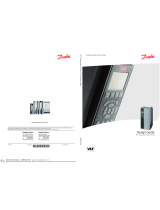
subject to a short circuit on the output. A locked trip can
only be cancelled by cutting off mains, removing the cause
of the fault, and reconnecting the frequency converter.
Restart is prevented until the trip state is cancelled by
activating reset or, in some cases, by being programmed
to reset automatically. Do not use trip may for personal
safety.
VT characteristics
Variable torque characteristics for pumps and fans.
1.6 Document and Software Version
This manual is regularly reviewed and updated. All
suggestions for improvement are welcome.
Table 1.2 shows the document version and the
corresponding software version.
Edition Remarks Software version
MG20N6xx Replaces MG20N5xx 2.20 and later
Table 1.2 Document and Software Version
1.7 Approvals and Certifications
Frequency converters are designed in compliance with the
directives described in this section.
For more information on approvals and certificates, go to
the download area at http://www.danfoss.com/Busines-
sAreas/DrivesSolutions/Documentations/.
1.7.1
CE Mark
Illustration 1.1 CE
The CE mark (Communauté Européenne) indicates that the
product manufacturer conforms to all applicable EU
directives. The EU directives applicable to the design and
manufacture of frequency converters are listed in Table 1.3.
NOTICE
The CE mark does not regulate the quality of the
product. Technical specifications cannot be deduced
from the CE mark.
NOTICE
Frequency converters with an integrated safety function
must comply with the machinery directive.
EU directive Version
Low voltage directive 2006/95/EC
EMC directive 2004/108/EC
Machinery directive
1)
2006/42/EC
ErP directive 2009/125/EC
ATEX directive 94/9/EC
RoHS directive 2002/95/EC
Table 1.3 EU Directives Applicable to Frequency Converters
1) Machinery directive conformance is only required for frequency
converters with an integrated safety function.
Declarations of conformity are available on request.
1.7.1.1
Low Voltage Directive
The low voltage directive applies to all electrical
equipment in the 50–1000 V AC and the 75–1600 V DC
voltage ranges.
The aim of the directive is to ensure personal safety and
avoid property damage, when operating electrical
equipment that is installed and maintained correctly, in its
intended application.
1.7.1.2
EMC Directive
The purpose of the EMC (electromagnetic compatibility)
directive is to reduce electromagnetic interference and
enhance immunity of electrical equipment and instal-
lations. The basic protection requirement of the EMC
Directive 2004/108/EC states that devices that generate
electromagnetic interference (EMI), or whose operation
could be affected by EMI, must be designed to limit the
generation of electromagnetic interference and shall have
a suitable degree of immunity to EMI when properly
installed, maintained, and used as intended.
Electrical equipment devices used alone or as part of a
system must bear the CE mark. Systems do not require the
CE mark, but must comply with the basic protection
requirements of the EMC directive.
1.7.1.3
Machinery Directive
The aim of the machinery directive is to ensure personal
safety and avoid property damage, for mechanical
equipment used in its intended application. The machinery
directive applies to a machine consisting of an aggregate
of interconnected components or devices of which at least
one is capable of mechanical movement.
Frequency converters with an integrated safety function
must comply with the machinery directive. Frequency
converters without safety function do not fall under the
machinery directive. If a frequency converter is integrated
into a machinery system, Danfoss can provide information
on safety aspects relating to the frequency converter.
Introduction
Design Guide
MG20N602 Danfoss A/S © 09/2014 All rights reserved. 11
1
1





















